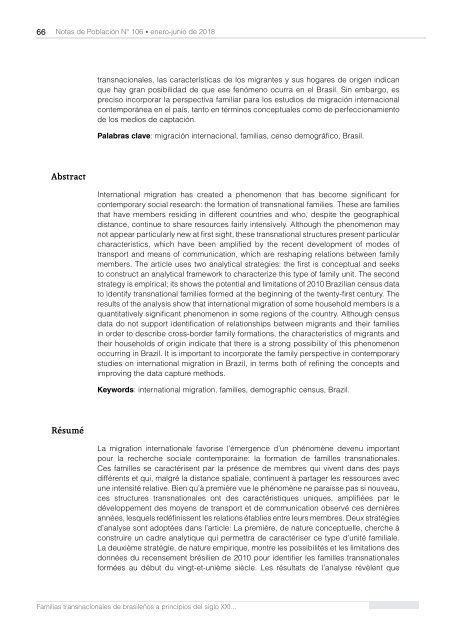Notas de Población N° 106
El número 106 de Notas de Población está conformado por 10 artículos, en cuya elaboración han participado 21 colaboradores. Los artículos abordan diversos temas de investigación relacionados con la mortalidad, el transnacionalismo migratorio y la fecundidad de las migrantes, así como la fecundidad adolescente, el femicidio, la migración de retorno, la segregación en el espacio urbano y el dividendo demográfico.
El número 106 de Notas de Población está conformado por 10 artículos, en cuya elaboración han participado 21 colaboradores. Los artículos abordan diversos temas de investigación relacionados con la mortalidad, el transnacionalismo migratorio y la fecundidad de las migrantes, así como la fecundidad adolescente, el femicidio, la migración de retorno, la segregación en el espacio urbano y el dividendo demográfico.
You also want an ePaper? Increase the reach of your titles
YUMPU automatically turns print PDFs into web optimized ePapers that Google loves.
66<br />
<strong>Notas</strong> <strong>de</strong> <strong>Población</strong> <strong>N°</strong> <strong>106</strong> • enero-junio <strong>de</strong> 2018<br />
transnacionales, las características <strong>de</strong> los migrantes y sus hogares <strong>de</strong> origen indican<br />
que hay gran posibilidad <strong>de</strong> que ese fenómeno ocurra en el Brasil. Sin embargo, es<br />
preciso incorporar la perspectiva familiar para los estudios <strong>de</strong> migración internacional<br />
contemporánea en el país, tanto en términos conceptuales como <strong>de</strong> perfeccionamiento<br />
<strong>de</strong> los medios <strong>de</strong> captación.<br />
Palabras clave: migración internacional, familias, censo <strong>de</strong>mográfico, Brasil.<br />
Abstract<br />
International migration has created a phenomenon that has become significant for<br />
contemporary social research: the formation of transnational families. These are families<br />
that have members residing in different countries and who, <strong>de</strong>spite the geographical<br />
distance, continue to share resources fairly intensively. Although the phenomenon may<br />
not appear particularly new at first sight, these transnational structures present particular<br />
characteristics, which have been amplified by the recent <strong>de</strong>velopment of mo<strong>de</strong>s of<br />
transport and means of communication, which are reshaping relations between family<br />
members. The article uses two analytical strategies: the first is conceptual and seeks<br />
to construct an analytical framework to characterize this type of family unit. The second<br />
strategy is empirical; its shows the potential and limitations of 2010 Brazilian census data<br />
to i<strong>de</strong>ntify transnational families formed at the beginning of the twenty-first century. The<br />
results of the analysis show that international migration of some household members is a<br />
quantitatively significant phenomenon in some regions of the country. Although census<br />
data do not support i<strong>de</strong>ntification of relationships between migrants and their families<br />
in or<strong>de</strong>r to <strong>de</strong>scribe cross-bor<strong>de</strong>r family formations, the characteristics of migrants and<br />
their households of origin indicate that there is a strong possibility of this phenomenon<br />
occurring in Brazil. It is important to incorporate the family perspective in contemporary<br />
studies on international migration in Brazil, in terms both of refining the concepts and<br />
improving the data capture methods.<br />
Keywords: international migration, families, <strong>de</strong>mographic census, Brazil.<br />
Résumé<br />
La migration internationale favorise l’émergence d’un phénomène <strong>de</strong>venu important<br />
pour la recherche sociale contemporaine: la formation <strong>de</strong> familles transnationales.<br />
Ces familles se caractérisent par la présence <strong>de</strong> membres qui vivent dans <strong>de</strong>s pays<br />
différents et qui, malgré la distance spatiale, continuent à partager les ressources avec<br />
une intensité relative. Bien qu’à première vue le phénomène ne paraisse pas si nouveau,<br />
ces structures transnationales ont <strong>de</strong>s caractéristiques uniques, amplifiées par le<br />
développement <strong>de</strong>s moyens <strong>de</strong> transport et <strong>de</strong> communication observé ces <strong>de</strong>rnières<br />
années, lesquels redéfinissent les relations établies entre leurs membres. Deux stratégies<br />
d’analyse sont adoptées dans l’article: La première, <strong>de</strong> nature conceptuelle, cherche à<br />
construire un cadre analytique qui permettra <strong>de</strong> caractériser ce type d’unité familiale.<br />
La <strong>de</strong>uxième stratégie, <strong>de</strong> nature empirique, montre les possibilités et les limitations <strong>de</strong>s<br />
données du recensement brésilien <strong>de</strong> 2010 pour i<strong>de</strong>ntifier les familles transnationales<br />
formées au début du vingt-et-unième siècle. Les résultats <strong>de</strong> l’analyse révèlent que<br />
Familias transnacionales <strong>de</strong> brasileños a principios <strong>de</strong>l siglo XXI...


















